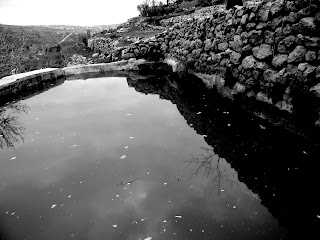Here is a report from a hike I did about a week ago. This is a really neat hike. Here are pictures and a map of where we went. On the map the part that says Rephaim Valley is the part we hiked. The place that we live is along the Kiriat Yearim Ridge. Thanks to my roommate, Andrew Scott Harasick son of Mr. Harasick, for making this map because i don't know how to do anything like this.
We started off the day with a worship service at our church in Jerusalem and then we jumped in the bus which took us to the zoo; the zoo being our launch pad for the hike. The Valley of Rephaim has a significant part in access through the hill country of Judea. This valley is called an emek, which means that that valley is a bit wider than normal in the base of the canyon. The Hill Country tends to be steep mountains and sharp cutting valleys, which make it hard to travel in. The main and most popular option has been to travel along the ridges and avoid the valleys, but in some cases, like the Valley of Rephaim, the valleys are wide enough to walk a whole army through. In fact the Philistines did just that when David was king in Jerusalem. We read in 2 Samuel 5:17-25 that the Philistines tried to attack Jerusalem twice through the Valley of Rephaim, and twice God delivered them into King David’s hand. The first time David went straight at them with his army and pushed them back. The second time they tried to attack David God told them to go up around the Philistines and hit them from the back. They did this and they ended up pushing them all the way past Jerusalem and up to the Beth-Horon Ridge Route and out to Gezer. With God’s help King David crushed the Philistines and drove them back into the Coastal Plain.
The Valley of Rephaim is actually a branch of the Sorek Valley. The spot in which it branches is very steep and not friendly to travelers. It is when the valley passes Bether that it widens and becomes friendly for travelers. Bether is a major city in that it blocks the path must be traveled by people travelers in the Valley of Rephaim. Bether is mentions once in Song of Solomon 2:17 when the author says his beloved is like a “gazelle or stag in the mountains of Bether.” Bether is also the last stand f Bar Kochva. He was the man that led the second Jewish revolt against Roman authorities in 132-135 A.D. The eastern border of the valley is the Hinnom Mountain ridge. If a drop of water fell directly on top of the mountain half of it would fall into the Hinnom Valley and half would fall into the Valley of Rephaim. You can see why this would be a good way to attack Jerusalem. It gets the attackers right up the Hinnom Valley, which is right outside the city walls.
We set off the Valley of Rephaim and stopped at our first of three springs. It was called Ein Lavan. This is an easily accessible place so many people were up there. The spring was beautiful and the wall built up around it served as a nice seat. There we met a man of a horse and watched Bill try to feed the horse carrots. We also talked to some older Jewish people. They were friendly and curious as to what we were doing in Israel. At the end one lady wanted to make sure that we knew the Sabbath was a special day for them and it was like no other, so she repeated it a couple times. Before we got to this spring we stopped at one of the Olive trees in the valley and listened to Bill give an educational/devotional talk on the Olive tree. He explained how they can cut open the tree and graft in branches and they will grow just like a normal branch would grow. In Romans Paul talks about the same thing, but instead of Talked about olive trees and branches he talked about Gentiles and Christianity. Gentiles are grafted into the faith just like a branch is grafted into an olive tree to grow and produce fruit. This next spring was called Ein Hinyeh. At this spring we meet some shepherds and two of the girls got to ride on the donkey they had with them. We looked around for awhile and climbed on the rocks there. I noticed that there was a lot of pottery surrounding this spring. Springs tend to be surrounded by pieces of pottery because it is where they get water and pots usually break. On our way to the next spring we saw a abandoned excavation. This was probably a Byzantine period discovery which doesn’t mean much in Israel. That is a interesting point because if something like that were found in America it would make front page news on every newspaper, but in Israel it wasn’t worth someone’s time. Then we went to our last spring, Ein Balad. There were some teenagers hanging out at this spring. They were making some tea with the water from the spring. This spring was very clear and looked fresh. We sat down and made a fire, sang some songs, and drank coffee before we headed up to the road to get picked up by our bus.
The Rephaim Valley
The First Spring; Ein Lavan
A Guy on a Horse.
Rephiam Valley





No comments:
Post a Comment